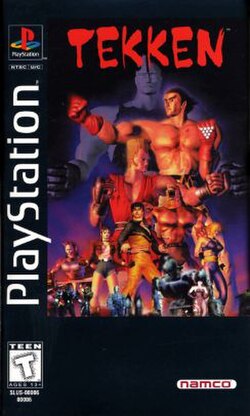Tekken (video game)
| Tekken | |
|---|---|

Cover of North American PlayStation version
|
|
| Developer(s) | Namco |
| Publisher(s) | Namco |
| Director(s) | Seiichi Ishii |
| Producer(s) | Hajime Nakatani |
| Designer(s) | Seiichi Ishii |
| Composer(s) | Yoshie Arakawa Yoshie Takayanagi |
| Series | Tekken |
| Platform(s) | Arcade, PlayStation, PlayStation 2, PlayStation Network |
| Release |
Arcade PlayStation PlayStation Network |
| Genre(s) | Fighting |
| Mode(s) | Single-player, multiplayer |
| Cabinet | Upright |
| Arcade system | Namco System 11 |
| CPU | 1x PSX CPU @ 16.9344 MHz, 1x Hitachi H8/3002 @ 16.384 MHz |
| Sound | 1x Namco C352 @ 16.384 MHz |
| Display | Horizontal orientation, Raster, 640 x 480 resolution |
| Review scores | |
|---|---|
| Publication | Score |
| Edge | 9 of 10 |
| Famitsu | 38 of 40 (PS) |
| IGN | 7.5 of 10 (PS) |
| Maximum |
|
Tekken (also known as Tekken 1) is a fighting video game developed and published by Namco. It was released in arcades in December 1994 and on the PlayStation in 1995. It was the first entry in the popular Tekken series, succeeded by Tekken 2 in August 1995. The arcade game features eight playable characters, while the PlayStation version features 18 playable characters in the roster.
As with many fighting games, players choose a character from a lineup, and engage in hand-to-hand combat with an opponent. Unlike most fighting games of the time, Tekken allows the player to control each of the fighter's four limbs independently. The player can watch the animation on screen and figure out the appropriate command (if the character kicks low with their right leg, the move is likely to be executed by pressing down and right kick, or a similar variation). By default, there are two rounds of combat. However, the players have a choice from one to five rounds, as well as options for the time limit of each round. If the time limit for the round expires, the character with more health remaining will be declared the winner; if one does not exist, the round will be a draw.
In the game, the name of the location is displayed in the bottom right corner of the screen. Unlike in the sequels, the locations were all representations of real places and included Chicago (USA), Windermere (Great Britain), Monument Valley (USA), Angkor Wat (Cambodia), Szechwan (China), Kyoto (Japan), Fiji (Fiji), Venezia (Italy), Acropolis (Greece), King George Island (Antarctica), and Chiba Marine Stadium (Japan).
...
Wikipedia
